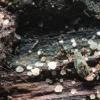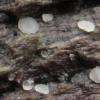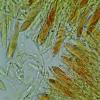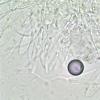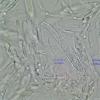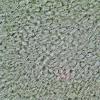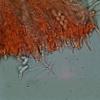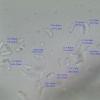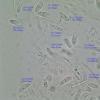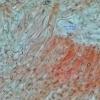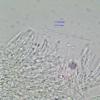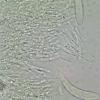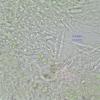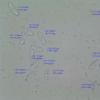
12-11-2025 09:25
 Viktorie Halasu
Viktorie Halasu
Hello, I need help with a pale terrestric Pseudom

11-11-2025 20:16
Bohan JiaHi, lastly I have found these tiny yellow decayin

09-11-2025 13:20
Hello.A tiny ascomycete, appearing as erupting gra

08-11-2025 00:29
 Francois Guay
Francois Guay
I found this species in Quebec, Canada, on herbace
Calycina (?) sp.
éric ROMERO,
02-04-2024 16:24

Bonjour,
J'ai besoin de votre aide pour ce petit asco blanc.
Récolté sur bois de conifère (Pinus sylvestris probable) très dégradé, fortement humide et colonisé pas Chlorociboria sp., secteur tourbière du Waldeck (F-67) le 17/03/24.
Apothécies sessile, discoïdes, d'abord sphériques, puis à marge flexueuse, blanches, translucides, très fragiles, n'excédant pas 0,6mm, faiblement adhérentes au support.
Asques clavés, inoperculés, crochet +, bituniquées, IKI + (Bleu). 50-65 X 6,5-8µ.
Paraphyses cylindriques, glabres, extrémités arrondies, septées (peu et/ou irrégulièrement), guttulées, ne dépassant pas des asques.
Excipulum textura angularis-globulosa.
Poils filiformes, hyalins, pointus, peu nombreux et isolés.
Spores ellipsoïdes-oblongues, hyalines, septés (1 cloison +/- centrale, rarement 2 observées), parfois guttulées de manière variable (souvent plusieurs petites guttules ou parfois 1 guttule moyenne par segment). (7,1) 8-10,5 (11) X 2,7-3,8µ.
Merci d'avance pour vos commentaires, éric.
Hans-Otto Baral,
02-04-2024 16:47

Re : Calycina (?) sp.
The hairs are important, woh long are they and are they always such tapering? Never glassy at the top?
These guttules in excipulum and paraphyses occur e.g. in Hyaloscypha vitreola but also in Mimicoscypha (previously Phialina) lacrimiformis and apparently in Resinoscypha variepilosa (not sure). But all have rather long hairs and longer or narrower spores.
éric ROMERO,
02-04-2024 22:45

Re : Calycina (?) sp.
Bonjour Zotto,
J'ai encore de la matière donc j'ai repris 5 ou 6 exemplaires pour refaire des images des poils et les mesurer. Ils sont lisses, pointus à légèrement arondis, plus épais vaers la base. Les mesures sont comprises entre 34 - 39 x 1,9 - 2,7, une dizaine de poils mesurés.
Après cette orientation et de nouvelles recherches, Hyaloscypha albohyalina serait-il un bon candidat ?
éric.
Hans-Otto Baral,
03-04-2024 09:58

Re : Calycina (?) sp.
My impression is that the spores are non-septate when inside living asci and septation occurs only after ejection or inside dead asci. But this should be verified. Hyaloscypha in the wide sense appears to me rather clear, but today some members of the genus were transferred to new genera, I remember H. paludosa is not Mimicoscypha paludosa.
éric ROMERO,
03-04-2024 16:03
Hans-Otto Baral,
03-04-2024 16:15

Re : Calycina (?) sp.
So here you have purely non-septate spores. DNA would surely help, but the apos must be clean, dangerous is to use some which were several days in the fridge. I hope you have your photos also without piximeter, this method is quite disturbing and hides the spores, much better is a single scale for each photo and only a collective measurement.
éric ROMERO,
03-04-2024 16:43

Re : Calycina (?) sp.
La météo le permettant, les apos son dans le jardin. Par contre, pour les photos, je n'ai pas gardé celles sans les mesures..., je le ferai pour mes prochaines études.
Merci beaucoup pour l'aide apportée et les conseils, éric.
Kosonen Timo,
06-04-2024 14:24

Re : Calycina (?) sp.
Hi,
This is an interesting sample. To me it looks very much like Mimicoscypha with the frequent guttules in excipulum and in the hairs especially. However, we have observed M. lacrimiformis both with and without guttules at the same locality / date and both later found 100% identical (sequence). M. lacrimiformis (the only Mimicoscypha sequenced) is a possibilty. M. mimica is another option as it also has crozier.
Resinoscypha (variepilosa) is yet another option. It too has guttules inside cells, spores usually <10 um long. Developing hairs bulky and not evenly tapering - proportionally wider compared to mature hairs that are more typical thin-walled multiseptate tapering etc. And it has cyanophilous substance ("resin") inside the hairs. Thereäs something non-Resinoscypha-like in the macro.
I dont find these very easy. Resinoscypha is fairly common here Spring and Autumn like. Often I have thought I found Mimicoscypha only to find out based on sequence it is a Resinoscypha after all. Mimicoscypha possibly a Spring season species, but not enough n to really believe that myself.
It could be something else too... These hyaloscyphoids with multiseptate hairs have many homes :-)
Timo
This is an interesting sample. To me it looks very much like Mimicoscypha with the frequent guttules in excipulum and in the hairs especially. However, we have observed M. lacrimiformis both with and without guttules at the same locality / date and both later found 100% identical (sequence). M. lacrimiformis (the only Mimicoscypha sequenced) is a possibilty. M. mimica is another option as it also has crozier.
Resinoscypha (variepilosa) is yet another option. It too has guttules inside cells, spores usually <10 um long. Developing hairs bulky and not evenly tapering - proportionally wider compared to mature hairs that are more typical thin-walled multiseptate tapering etc. And it has cyanophilous substance ("resin") inside the hairs. Thereäs something non-Resinoscypha-like in the macro.
I dont find these very easy. Resinoscypha is fairly common here Spring and Autumn like. Often I have thought I found Mimicoscypha only to find out based on sequence it is a Resinoscypha after all. Mimicoscypha possibly a Spring season species, but not enough n to really believe that myself.
It could be something else too... These hyaloscyphoids with multiseptate hairs have many homes :-)
Timo
Kosonen Timo,
06-04-2024 16:51

Re : Calycina (?) sp.
sorry for the missing verbs, but maybe that was understandable still... or maybe no sense at all :-) :-) :-)
Timo
Timo
éric ROMERO,
06-04-2024 18:35

Re : Calycina (?) sp.
Hi Timo,
Thank you very much for your answer and all is goo life that.
I continue my research, the biggest difficulty is to find documentation. Didier Argaut will help me, and if it's necessary, we will sequence this species.
éric.

